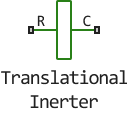Translational Inerter
Inertia in mechanical translational systems.
blockType: AcausalFoundation.Mechanical.Translational.Elements.Inerter
|
Path in the library: |
Description
The Translational Inerter block is a device that gives off force proportional to the rate of change in relative velocity (acceleration) between ports. It is essentially an inerter unit that operates on the difference in velocity between ports, rather than absolute velocity. An inerter is the mechanical equivalent of a capacitor. An inerter with a single port connected to a reference point essentially behaves as a mass with a value equal to the inertia of the inerter.
This unit can be used in models of high performance suspension systems or in modelling a passively tuned response of the mass-spring-shock absorber type.
The block is described by the following equations:
where
|
Force transmitted through the inerter |
|
Inertia |
|
Relative speed |
|
Absolute speeds on R and C ports respectively |
Positive direction of the block from port R to port C. This means that the force is positive if it acts in the direction from R to C.
Ports
R is a mechanical port
` translational mechanics'.
Mechanical Progressive Port.
C is a mechanical port
`translational mechanics'.
Mechanical progressive port.
Parameters
Inertance, kg - inertia
1.0 kg (by default)
Coefficient of proportionality between force and rate of change of relative velocity.
Initial value of velocity, m/s - initial value of velocity
0.0 (By default).
Initial value of velocity.
Initial value of force, N - initial value of force
`0.0 (by default).
Initial value of force.
